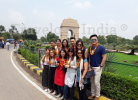Top Memorials in Delhi
Delhi is the capital city of India. There are very famous monuments that form a part of this city. Along with this there are many memorials in Delhi which are dedicated to the heroes of our country. You will feel delighted to visit each one of these as they beautifully unfold the life saga of individuals who have selflessly served India and its citizens. Must visit Memorials include:
This grand arch stands at Rajpath commemorating the sacrifice of life made by Indian soldiers in World War I. It was constructed in Indo-sarscenic architectural style during the British rule. One striking feature of this memorial is the ‘Amar Jawan Jyoti’. This is an inverted rifle with a soldier’s helmet on it surrounded by never-going-to-douse flames on four corners. It symbolises the never dying spirit of the soldiers and their immortality. It is now regarded as the tomb of every Indian soldier who lost his life in the war ground fighting for the honour and pride of his country.
2. Mutiny Memorial
As the name suggests, this memorial is for the ones (Indian and British Delhi force) who died during the first freedom struggle of India that took place in 1857 (which is also called as the Sepoy Mutiny). This memorial is situated in Kashmiri Gate and is also known as Ajitgarh. Receiving criticism for the inscriptions on the memorial, the government on 25th anniversary of India’s independence, put up a stone on which it is written that the people who are referred to here with the use of word ‘enemy’ are actually the immortal martyrs of 1857 freedom struggle.
3. Rajghat
This is the memorial of Mahatma Gandhi, the father of our nation (as called in India). He was one of the greatest leaders the whole world had ever seen and his last rites were performed at this place. Here, his ideology and life are beautifully unfurled everyday (except Monday) using photographs, pictures, sculptures etc. The mahatma’s memorial is represented by the black marble platform where a large number of visitors (VIPs and ordinary people) come to pay their homage to him.
4. Shantivan
This is situated to the north of Rajghat and is the place where the last rites of the first Prime Minister of India, Pt. Jawahar Lal Nehru were performed. The name to this memorial symbolises the peace-loving nature of Chacha Nehru (as he is popularly known in India) as it literally translates to the ‘Forest of Peace’ in English. A gravestone stands over here at his cremation site.
5. Vijay Ghat
This is the memorial of second prime minster on India, Shri Lal Bahadur Shastri. He died of a heart attack when he went on a peace mission in Tashkent, Russia. Vijay Ghat translates to the ‘Victory Bank’ in English. Such a name has been given to his memorial because under his leadership, India emerged victorious in the 1965 Indo-Pak War.
6. Shakti Sthal
The name clearly suggests (translating to the ‘Place of Power’) that this memorial has been built for someone who was one of the most powerful people this world has ever seen, Indira Gandhi. Known as the Iron Lady of India, she stood up to her name all through her life. It was here at Shakti Sthal that her last rites were performed after she was assassinated by her Sikh bodyguards. There is a large grey monolith erected on her cremation site.
7. Veer Bhumi
This is one of the most gracefully built samadhis in Delhi. It is dedicated to the former Prime Minister of India, Shri Rajiv Gandhi. He was also assassinated and thus the name has been given to his memorial ‘Veer Bhumi’ which means Land of the brave. The architectural finesse is worth praising here as a fully bloomed lotus is surrounded by forty six lotuses signifying his age of death.
















